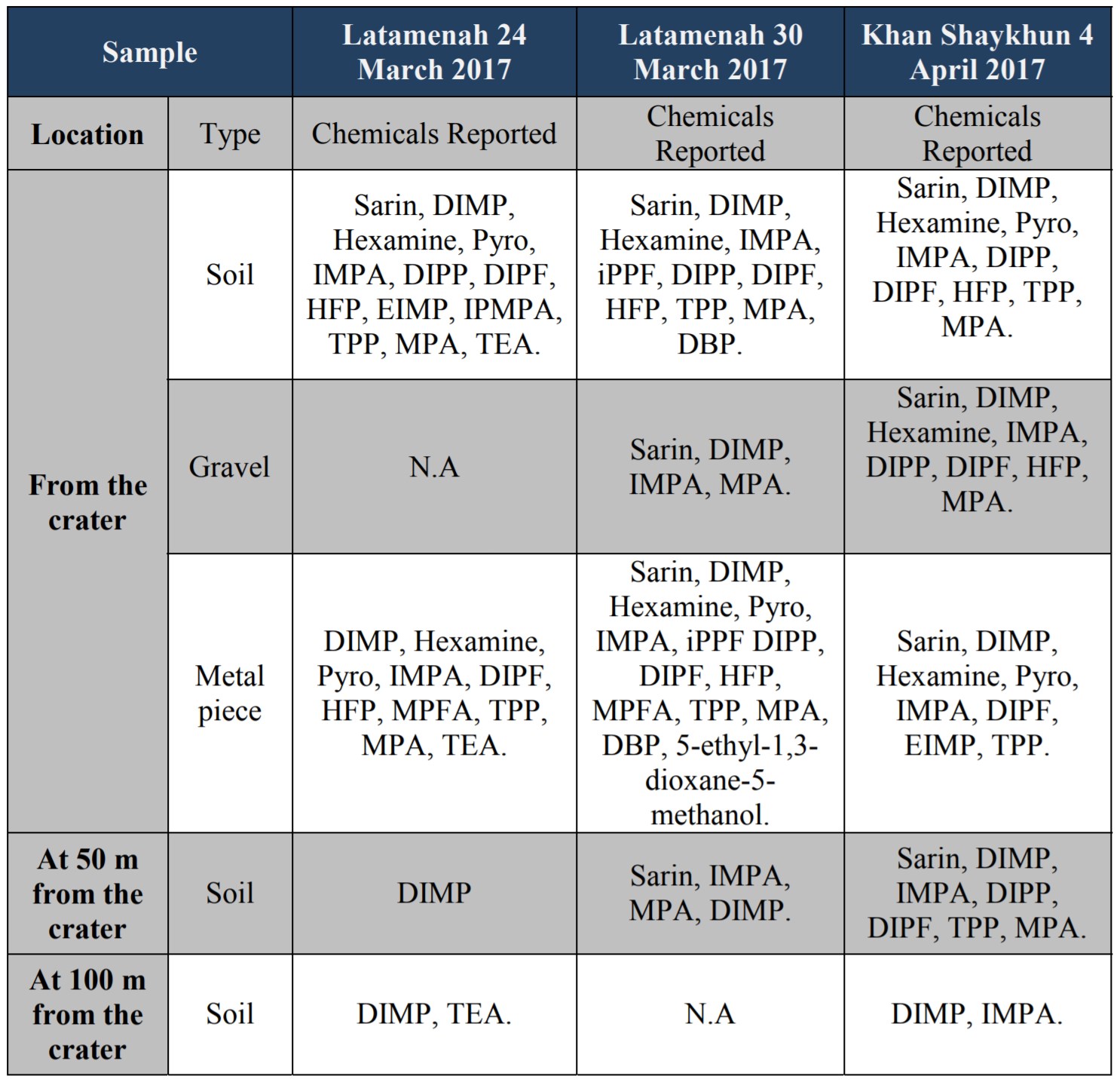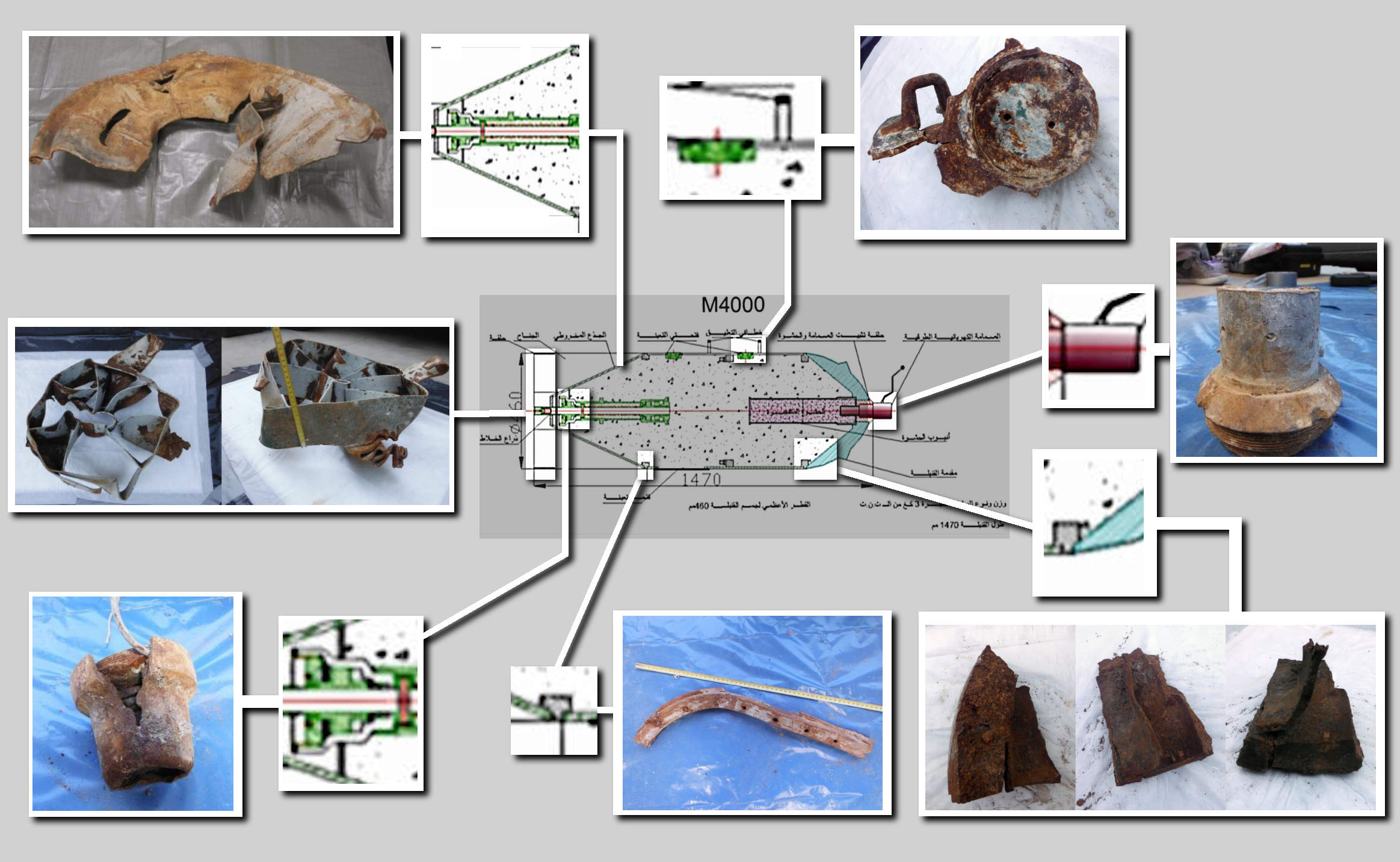What We Know About Hexamine and Syria's Sarin
After 6 years of chemical attacks in Syria, many details have been gathered about the nature of chemical weapon use in Syria, including the munitions and chemical agents used. With frequent accusations by defenders of the Syrian government that Sarin attacks have been false flags or other attempts at deception by Syrian opposition groups and NGOs, the chemical composition of the Sarin used in these attacks has been of great interest and a subject of heated debate. Since the August 21st 2013 Sarin attacks the use of one chemical in particular, hexamine, has been hotly debated by those focused on the use of Sarin as a chemical weapon in Syria. Thanks to reports published by the OPCW and others, we now have a much better idea of hexamine’s role in Sarin attacks, and the implications of that use.
Hexamine first became a topic of debate after it was identified in samples gathered by the United Nations Mission to Investigate Allegations of the Use of Chemical Weapons in the Syrian Arab Republic in their report on the August 21st 2013 Sarin attacks in Damascus. In October 2013 the Syrian government had declared details of their chemical weapons program to the OPCW, including 80 tonnes of hexamine, a vast amount of a substance not typically linked to chemical weapon programs. In a military context, hexamine was associated with the manufacturing of explosives, not the manufacturing of chemical weapons.
With hexamine declared as part of Syria’s chemical weapon program, and hexamine identified in multiple samples from the August 21st 2013 Sarin attacks in Damascus, some chemical weapon specialists, in particular Dan Kazseta, proposed that the presence of hexamine in the samples gathered from those attacks indicated it could be used by the Syrian government as part of their Sarin manufacturing process, and the declaration of hexamine as part of Syria’s chemical weapon program further supported that theory.
In a detailed examination of why hexamine would be used in the Sarin manufacturing process, Dan Kaszeta explained that in the various documented Sarin manufacturing processes “all of the production paths end with either hydrogen chloride (HCl) or hydrogen fluoride (HF) as a by-product”. Those by-products are particularly problematic, in particular hydrogen fluoride (HF), as they are highly corrosive and reduces the shelf life of Sarin produced by the chemical process dramatically. To counter this, what’s known as an acid scavenger is added to the mixture, reducing the amount of acid in the final product, increasing the shelf life, and prevent it from eating through the munition or storage container it has been placed in. The most widely used acid scavengers in Sarin production are part of the amine chemical family, to which hexamine belongs.
Kaszeta states that while amines have been used as acid scavengers by various nations, the use of hexamine as an acid scavenger had not been documented, therefore making the apparent use of hexamine in the Syrian government’s Sarin manufacturing process unique. This meant the presence of hexamine in Sarin used in Syria pointed to the source of the Sarin being the Syrian government’s Sarin manufacturing process, acting like a chemical fingerprint linking Sarin attacks to the government.
This theory was supported in an interview with Ake Sellstrom, the head of the United Nations Mission to Investigate Allegations of the Use of Chemical Weapons in the Syrian Arab Republic, in CBRNe World magazine:
Winfield– Why was hexamine on the list of chemical scheduled to be destroyed – it has many other battlefield uses as well as Sarin? Did you request to put it on the list or had the Syrian’s claimed that they were using it?
Sellstrom– It is in their formula, it is their acid scavenger.
In addition, Sellstrom stated he had asked the Syrian government how the rebels could have got hold of chemical weapons:
“They have quite poor theories: they talk about smuggling through Turkey, labs in Iraq and I asked them, pointedly, what about your own stores, have your own stores being stripped of anything, have you dropped a bomb that has been claimed, bombs that can be recovered by the opposition? They denied that.
To me it is strange. If they really want to blame the opposition they should have a good story as to how they got hold of the munitions, and they didn’t take the chance to deliver that story.”
However, there were those who attacked the idea of hexamine being used as an acid scavenger. Following his earlier reports on the range of the rockets used in the August 21st 2013 Sarin attack on Eastern Ghouta (one of two areas of Damascus attacked with Sarin on August 21st 2013), Ted Postol, professor emeritus at the Massachusetts Institute of Technology (MIT), published a report attacking the work of Dan Kaszeta, titled “A Brief Assessment of the Veracity of Published Statements in the Press and Elsewhere Made by Dan Kaszeta, A Self-Described Expert on the Science and Technology of Chemical Weapons“.

Ted Postol on RT discussing the Khan Sheikhoun Sarin attack (source)
The report relied heavily on Postol’s consultations with Maram Susli, aka Mimi al-Laham/PartisanGirl/Syrian Girl/Syrian Sister, an Australian chemistry student and pro-Assad YouTube blogger, now a contributor to Alex Jones’ InfoWars conspiracy website, and her advice on chemical weapons, in particular regarding the solubility of hexamine in a Sarin precursor, isopropanol.

Mimi Al Laham discussing Syria with Alex Jones on InfoWars (source)
The issue of the solubility of hexamine in isopropanol was presented by Postol as evidence that hexamine could not be possibly used as an acid scavenger, but this made assumptions about the exact process used to mix the precursors used to produce the Sarin used in the August 21st 2013 attacks. Dan Kaszeta countered this claim by stating that it wouldn’t necessarily be required that hexamine is dissolved in the isopropanol as this is only really necessary in binary Sarin munitions that mix in flight, and there was no indication that the munitions used on August 21st 2013 were mix in flight munitions. However, Postol rejected this theory, and published his 44 page report attacking Dan Kaszeta and his work, even going as far as describing claims by Dan Kaszeta’s reported in a New York Times article on the August 21st 2013 attacks as “fraudulent”.
Since Kaszeta’s original claims and Postol’s report, many more facts have entered the public domain about Syria’s Sarin, mostly thanks to OPCW investigations into Sarin attacks that took place in 2017, but it was a French National Evaluation about the Khan Sheikhoun chemical in April 2017 that provided the first significant piece of information on the use of hexamine, nearly 4 years after the August 21st 2013 Sarin attacks.
The French National Evaluation includes analyses carried out by French experts on samples gathered from the site of the April 4th 2017 Khan Sheikhoun Sarin attack, revealing “the presence of sarin, of a specific secondary product (diisopropyl methylphosphonate – DIMP) formed during synthesis of sarin from isopropanol and DF (methylphosphonyl difluoride), and hexamine”, adding:
“According to the intelligence obtained by the French services, the process of synthesizing sarin, developed by the Scientific Studies and Research Centre (SSRC) and employed by the Syrian armed forces and security services, involves the use of hexamine as a stabilizer. DIMP is also known as a by-product generated by this process.”
In an attempt to explain the presence of hexamine in samples gathered from the August 21st 2013 Sarin attacks, some had attempted to claim hexamine could be present in the environment for a whole range of reason, as it’s used in a number of manufacturing processes. The French National Evaluation included a key piece of information that undermined that claim; test results from a Sarin attack that took place in Saraqib, Idlib, on April 29th 2013.
During that attack a helicopter had flown across the town, dropping packages that included grenades containing Sarin. The use of Sarin had been confirmed by an earlier OPCW Fact Finding Mission (FFM) investigation, and the French National Evaluation revealed that one of the grenades had not exploded, and it contained “a solid and liquid mix of approximately 100ml of sarin at an estimated purity of 60%” along with “Hexamine, DF and a secondary product, DIMP”. This confirmed that hexamine was present inside the Sarin mixture, strong evidence that it was being used as an acid scavenger.
The French National Evaluation was followed by the OPCW Fact Finding Mission report on Khan Sheikhoun, which included multiple samples taken from the impact site and surrounding area, that revealed hexamine along with Sarin and Sarin by-products.
The OPCW-UN Joint Investigative Mission (JIM) report on Khan Sheikhoun published in October 2017 revealed even more details about the presence of hexamine in the samples taken from Khan Sheikhoun. The report stated
“According to information obtained by the Mechanism, the filler cap, with two closure plugs, is uniquely consistent with Syrian chemical aerial bombs. The Mechanism was provided with an assessment of the filler cap and with chemical analysis showing sarin and a reaction product of sarin with hexamine that can be formed only under very high heat. Information was also received that additional metal fragments collected from the crater might correspond to parts of Syrian aerial chemical munitions.”
It went on to state:
“The results of the analysis carried out by OPCW- designated laboratories confirm the presence of sarin and some of its known degradation products. Moreover, the results confirm that sarin was produced by the binary route, in which DF is combined with isopropanol (iPrOH) in the presence of hexamine.”
The report then stated that other chemicals present in the Sarin acted as marker chemicals that indicated the Sarin was very likely to have originated from the Syrian Arab Republic, and they indicated “a high degree of competence and sophistication in the production of DF [a Sarin precursor] and points to a chemical-plant-type production method.”
In addition, the report stated that:
“An initial screening of the reports concerning previous incidents of the release of sarin in the Syrian Arab Republic showed that some marker chemicals appeared to be present in environmental samples. This would warrant further study.”
In fact, some of these marker chemicals, along with hexamine, were present in samples taken from the August 21st 2013 Sarin attacks, and a report from Reuterspublished at the start of 2018 quoted OPCW sources who stated the same marker chemicals were found in samples taken from the Khan Sheikhoun attack, August 21st 2013 attacks, and an earlier Sarin attack in the town of Khan al-Assal in March 2013.
Khan al-Assal was significant as it was the first confirmed major Sarin attack, and the Russian government had shared a dossier of evidence with the UN that it claimed showed a rebel group was responsible, using homemade rockets, the specific type of which the Russians named, and claimed could be tied to a specific rebel group. The report has never been made public, and considering the complexity of the Sarin used in the Sarin attacks, the Syrian government’s insistence it had not lost control of its chemical weapons, and the Russian government’s refusal to publish the report it shared with the UN, it seems unlikely the Russian government was truthful about its claims.
Following Khan Sheikhoun, more OPCW Fact Finding Mission reports were published on Sarin attacks in Syria. Two lesser known attacks in the town of Al-Lataminah on March 24th and March 30th 2017, just before the Khan Sheikhoun attack, were investigated by the Fact Finding Mission, confirming the use of Sarin. In both attacks, hexamine was detected alongside other marker chemicals previously highlighted by the OPCW-UN JIM as connecting the Sarin used to the Syrian government, indicating the Sarin used in both attacks came from the Syrian government. In fact, the OPCW-FFM report explicitly highlighted the similarities between the Sarin and Sarin by-products found in samples from the two Al-Lataminah attacks and the Khan Sheikhoun attack.

Table from the OPCW FFM report on the March 24th 2017 Sarin attack in Al-Lataminah comparing samples taken from other Sarin attacks
In addition, debris recovered from the March 30th 2017 Sarin attack in Al-Lataminah matched to the filling cap recovered from the April 4th Sarin attack, which the OPCW-UN JIM state was “uniquely consistent with Syrian chemical aerial bombs”. Additional debris recovered from the March 30th 2017 attack site matched the design and dimensions of a M4000 Syrian chemical bomb. A diagram of the bomb was published by the Russian government during a press conference on the Khan Sheikhoun attack which revealed details about the construction of the bomb.

Debris recovered from the site of the March 30th 2017 Al-Lataminah Sarin attack compared to a diagram of a M4000 chemical bomb
Based on the diagram and debris recovered from the March 30th 2017 attack, it could be seen that the bomb had two filling caps, and two sections with a filling cap each separated by a barrier. A mixing arm inserted into the rear of the bomb was also visible. This was consistent with a description in an article published by Mediapart in June 2017 about the Syrian chemical weapons program, which detailed the process used to fill Syrian Sarin bombs:
“It also meant that engineers from the SSRC also had to design bombs that were specific for sarin, and which were quite different to ordinary munitions. “On the outside, they resemble conventional bombs of 250 and 500 kilos of TNT,” explained one of them. “But inside they were totally different, divided into two compartments. The first, at the front, carried the DF. The second, at the rear, [contained] the isopropyl and hexamine. This mixture is stirred together by a stirring rod that can be activated by sort of crank at the rear of the bomb. When the two compartments are filled up, a technician winds the crank which advances the stirring rod to the point it breaks the wall of mica. The sarin synthesis reaction is set off inside the bomb, placed under a cold shower and maintained within a very precise temperature range which is controlled by a laser thermometer,” continued the former SSRC source. “After which, all that’s left is to introduce, in the allocated hold at the point of the bomb, the explosive charge and detonator – altimetric, chronometric or other – and to place the bomb under the wing of the plane. The load must be very precisely measured. If it is too big, the heat given off can cause the decomposition of the product, or the formation of a cloud of gas too far from the ground, which would render it ineffective. In principle, a 250-kilo bomb contains 133 litres of sarin, a few kilos of TNT and a ballast to preserve the aerodynamic characteristics of the weapon. A 500-kilo bomb contains 266 litres of sarin. The ideal altitude for the explosion of the bomb is about 60 metres.””
This matches perfectly with the design visible in the diagram published by Russia, and the debris recovered from the Al-Lataminah March 30th 2017 attack site and shows how hexamine was used at the point of mixing. It shows that despite the claims of Ted Postol and Maram Susli about hexamine needing to be absorbed by the isopropanol, the actual process used by the Syrian government to fill its chemical bombs does not require that step. The presence of hexamine at every confirmed Sarin attack shows the hexamine is part of the Syrian government’s manufacturing process, and far from Dan Kaszeta’s claims being “fraudulent”, as Ted Postol claimed, he was in fact right all along.


